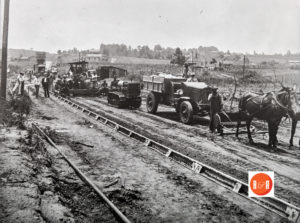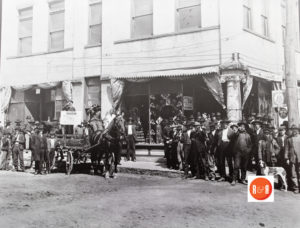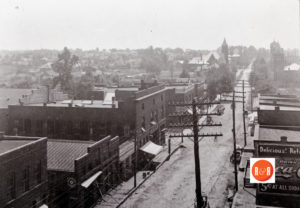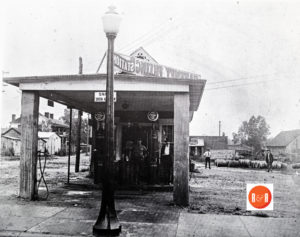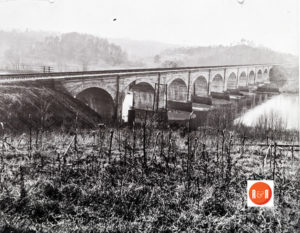BLACKSBURG, SOUTH CAROLINA IN THE 1880s
The Yorkville Enquirer reported on July 17th, 1873 – “The site of the post office previously known as Harmony has been changed to Black’s Station on the airline railroad and will now be known by that name.”
From the Yorkville Enquirer, March 2, 1892
Blacksburg held a celebration for the town and honored the original settlers of the community, first known as “Black’s Station.” In 1876, just after the completion of the Charlotte & Atlanta Air Line Railroad, there were 12 houses, 3 stores, a freight depot, a saw mill and a population of about 60.
The Rock Hill Herald reported on June 1, 1882 – “There has been $100,000. subscribed in Chester County for the Magnetic Manufacturing Co., which will build a factory on the site of the old Cherokee Ironworks on the Broad River.”
The Yorkville Enquirer reported on Jan. 4, 1883 – “Mr. C.M. Green has given a contract for building a hotel, which will be conducted in connection with a mineral spring owned by Mr. Green.” (Location unknown.)
The Yorkville Enquirer on Oct. 18, 1883 reported – “The colored Baptist at Black’s Station will soon complete their house of worship.” Also in the paper on Jan. 4, 1883 – “Mr. A.B. Crosby has bought a lot in Black’s Station and will soon erect a home.”
The Yorkville Enquirer reported on May 1, 1884 – “Dr. T.M. Whitesides has bought the Limestone Springs within the town limits of Black’s Station and has begun improvements by building walls for the springs and improving the grounds.”
The Yorkville Enquirer reported on April 17, 1884 – “Several families have left the Hickory Grove area to move to Black’s Station to take advantage of the opportunities there. They include; Dr. R.R. Darwin, Jerome Whisonant, D.C. McKinney, J.E. Plaxico, Dr. T.B. Whitesides, W.F. Dye, S.F. Brandon, A.B. Crosby, and B.W. Dawson.”
*** The Yorkville Enquirer reported on Feb. 2, 1887 – “Printed an item from the Shelby New Era reporting that L.M. Campbell of Scranton, Pa., purchased the Flint Hill Mine located in Union County from R.R. Darwin of Blacks. Campbell then sold the mine to a NY company.”
The Yorkville Enquirer reported on March 23, 1887 – “A contract was given to Mr. Thomas Hardeman for the construction of the 3 C’s Railroad Depot at Blacks and he has gone to work.”
The Yorkville Enquirer reported on Jan. 4, 1883 – “Mr. C.M. Green has given a contract for building a hotel, which will be conducted in connection with a mineral spring owned by Mr. Green.” (Location unknown.)
The Yorkville Enquirer reported on May 1, 1884 – “Dr. T.M. Whitesides has bought the Limestone Springs within the town limits of Black’s Station and has begun improvements by building walls for the springs and improving the grounds.”
The Yorkville Enquirer reported on April 9, 1885 – “In news from Black’s Station area Simon Brothers have opened up a bed of lime rock and will soon erect a kiln for the burning of lime. Mr. A.B. Huff is already operating a lime kiln. The lime here is pure and abundant found in a vein of deep blue rock.”
The Rock Hill Herald reported on Dec. 2, 1886 – “A sword hilt was exhibited in Gaffney one day last week which was found on the Cowpens Battlefield by Mr. Robert Scruggs. It is of pure silver and on it four last letters of Tarleton’s names are visible.”
The Yorkville Enquirer reported on March 27, 1889 – “The Magnetic Iron and Steel Ore Co., has been reorganized with a capital stock of $43,750. The 3C’s Railroad will begin a side track from Blacksburg to the Company’s mines, which are about three miles from town. The company will increase its operations and add more hands.”
Today, there are 7 churches, 2 schools with 324 pupils, 240 houses, 32 stores, 2 barbers, a livery, a market, 2 blacksmiths, a machine shop, a foundry, a sash and door factory, a planning and wood working mill, 2 ginneries, 2 grist mills, 2 saw mills, a spring hand factory, a tin shop, 2 shoe and harness shops, a barytic mill, a brick yard, 4 hotels, the machine shops and offices of the 3C Railroad, the Sulphuric Acid Mining & Manufacturing Company, the Magnetic Iron & Steel Ore Company, the Blacksburg Land & Improvement Company and 2 savings and loan associations.
Founded in 1897, with its largest city and county seat being Gaffney, Cherokee County was named after the Cherokee Indians. Prior to the Revolutionary War the Cherokee Indians used the area as a campground. Cherokee County was made possible by the coming of the railroad in 1893 and was carved out of Union, York, and Spartanburg Counties. The creation of the county was also made possible by secession movements by the citizens of Gaffney, Blacksburg, the townships of Limestone Springs, Draytonsville, White Springs, Gowdeysvlle, and Morgan in an election in December of 1896 and the General Assembly created the county in January of 1897.
- A collection of misc. images depicting the region. Courtesy of the Moss – Cobb Photo Collection, 2015. Enjoy thousands of these images scattered throughout the Cherokee County website.
In 1900 the population of Cherokee was 21,359 and it was mainly concentrated in the northern part of the county. Even with an established agricultural economy and a growing textile industry the economy of the county did not grow very quickly. By 1920, the population had only reached 27, 570 and the Great Depression and World War Two caused people to seek opportunities elsewhere. In 1940 Cherokee had add another 6,000 residents. A major growth did not occur in Cherokee until 1980 when the population grew to 40,983. Cherokee additionally grew in the decade between 1990 and 2000 when the county added new industries and became a bedroom community for York and Spartanburg counties.
The Yorkville Enquirer reported on Nov. 7, 1888 – “The Magnetic Iron and Steele Ore Company with investors in Atlanta, Birmingham and New York has leased and purchased about 10,000 acres in York, Spartanburg and Union Counties. They are working to identify the most valuable sources of iron ore. Their holdings include nearly all the property once owned by the Kings Mountain Iron Company. Col. John L. Black has recently discovered a rich load and he is the originator and managing director of the company. Prof. N.P. Pratt is a mining engineer working with him.”
The Yorkville Enquirer reported on Sept. 11, 1889 – “Last Monday John L. Black, representing the Magnetic Iron and Steel Ore Mining Co., paid W.B. Wilson, Jr., of Rock Hill, $12,000. for a tract of mineral land owned by him contiguous to the lands owned by the company.”
The Yorkville Enquirer reported on Oct. 30, 1889 – “Major Jones has sponsored the work of grading streets on the side of Whitaker Mountain. A drive of nearly a mile gives magnificent view of the town. The work is overseen by Capt. G.M. Moore, a veteran railroad man.”
The Yorkville Enquirer reported on March 13, 1889 – “The Magnetic Iron and Steel Ore Mining Company is prospering under the direction of Col. John L. Black. He has shipped about 120 tons of ore to Steelton, Penn., a car load to Richmond, and the first load to Birmingham.”
On July 3, 1889 the Yorkville Enquirer reported – “Mrs. M.E. Deal is having her residence painted by the veteran painter Nelson Davies.”
The Yorkville Enquirer reported on Sept. 10, 1890 – “A boarding house is being erected at the base of Whitaker Mountain by H.M. Angle.”
The Yorkville Enquirer reported on Jan. 21, 1891 quoting the Blacksburg News – “Col. John L. Black commenced operations to raise iron ore on a contract with John I. Middleton of Baltimore. He is now at work on the Black – Wilson Mine. The Magnetic Iron and Steel Ore Company has a contract with the Middleton firm to purchase 14,000 tons annually.” The Yorkville Enquirer of March 18, 1891 stated, “The annual meeting of the stock holders of the Magnetic Iron and Steel Co., will be held at the corporate office. ” – the paper also reported, “Mr. Black and Reese are opening up a sulphuret mine within the cooperate limits of Blacksburg. They will be testing the ore for the manufacture of sulfuric acid.”
The Yorkville Enquirer reported on April 22, 1891 – “The graded school for colored children is nearly completed.”
The Yorkville Enquirer reported on May 6, 1891 – “The committee appointed by the Blacksburg Town Council to examine the new school building for African American children has reported favorably and commend the work on the building. The bonds issued for this purpose will be turned over to Mr. H.M. Angle, the contractor.”
The Yorkville Enquirer reported on Nov. 4, 1891 – “Mr. Davis, the new operator at the Richmond and Danville Depot, moved his family here last week and they occupy the house on the corner of Shelby and Carolina streets.”
The Yorkville Enquirer reported on Feb. 4, 1891 – “Members of Mt. Paran Baptist Church, situated about two miles from Blacksburg, have recently erected a very neat and comfortable church building with dimensions of 30 ft by 54 ft.”
The Yorkville Enquirer reported on Dec. 2, 1891 – “Mt. Paran Baptist Church has completed its new building located about three miles north of Blacksburg. The church was organized in May 1853 by Peter Sapoch, Preston Harom, A.W. Holt, Abel Earl, Thomas Martin Sr., and the first pastor was the Rev. J.J. Jones. After a few years a small church was built and has been used until the present. The congregation decided about two years ago to build a new church. The building committee is W.J. Goforth – Chairman, James Martin, E.R. Sapoch, Albert Bettis, G.H. Martin and Thomas Martin. The membership today is 123 and the church has been built by some members giving money, some giving lumber, some giving brick and all giving their labor.”
On Dec. 2, 1891 the Yorkville Enquirer reported a commission has been issued by the Sec. of State to the Carolina Sulfuric Acid Man. Co. of Blacksburg. The capital stock is $300,000. and the purpose is to purchase mining properties and manufacture pyrites and sulfuric acid. The corporators are: Thomas B. Gautier of Morristown N.J., T.H.B. House of Wheeling, W.V. and John F. Jones and Blacksburg.”
The YV Enquirer reported on Feb. 10, 1892 – “Mrs. M.E. Deal has recently finished a neat and comfortable cottage at the corner of Clayiborne and Rutherford Streets and it was occupied last week by Rev. Hamiter, Pastor of the Pres. Church.”
The YV Enquirer reported on March 2, 1892 – “The Sec. of State has issued a charter to the S.C. Sulphuric Acid Company of Blacksburg. The directors are: Thomas Gautier, T.H.B. Hasse, and John F. Jones.”
The paper reported on May 30, 1894 – “Prof. Berghn of Philadelphia, a chemist for the Carolina Sulphuric Acid Manufacturing Company arrived a few days ago in Blacksburg and is getting the laboratory in order. Production at the mill will begin in about ten days.”
The Yorkville Enquirer reported on June 6, 1894 – “The laboratory of the Carolina Sulphuric Acid Manufacturing Co., is now in working order. Professor Burger is the chemist.” Later on May 22, 1895 the YC paper reported – “Work has been completed in lining the large acid chambers of the Sulphuric Acid plant with lead. The workers left for Montgomery, Al., where they have a similar contract.”
The third furnace of the Caloric Reduction Works, will be put in place this week. And they will soon begin crushing and roasting ores to manufacture Sulphuic Acid. Date: May 22, 1895…Also on this date, Mr. J.W. Rhyne is the contractor who began grading last week for the new Phosphate Works. Major John F. Jones manages the Phosphate, reduction, and acid works.”
The Rock Hill Herald reported on Jan. 21, 1903 – “That the Poag Mule Co., of Gaffney has moved its stock to the big new stable on Limestone Street.”
Cherokee had economically been part of the ‘Old Iron District’. During the 1700’s and 1800’s an iron industry flourished in the area but it was gone by the end of the Civil War. By 1880 railroad construction took over iron production and the Atlanta and Charlotte Air Lines crossed the counties. This established stations in Blacksburg and Gaffney. Following the coming of the railroads the textile mills began to be built. In 1882, the Cherokee Manufacturing Company was built, in 1892 the Gaffney Manufacturing Company, 1900 the Limestone Mills and 1907 Hamrick Mills. These mills were built by men such as J. A. Deal, Rufus P. Roberts, Joseph C Plonk, L Baker, Dr. Wylie C Hamrick, and Adolphus N. Wood. These men either lived in the community or moved there. Their mills encouraged a better wage than agriculture, better living conditions, and furnished employment for thousands in the community. Although many of the residents that lived in the southern part of the community were tied to agriculture and did not want to tie themselves to mill life. By 1880 the decline in cotton prices caused the farmers to seek other options. An option that arose to supplement the declining cotton prices was growing fruit, particularly apples and peaches. 364 bushels of peaches were produced in Cherokee in 1900.
The county was brought into the twentieth century by the textile mills which grew with employment during World War I and the 1920’s. While new technology suggested growth too much supply and not enough demand slowed mill production in the 1920’s. Cherokee Falls and Gaffney Manufacturing Mills did survive but they changed hands. The five Hamrick’s mills, like many others consolidated to continue running. During the next twenty years Cherokee experienced an economic downtown.
The production of the peach softened the blow that the Depression and its aftermath. In 1910 1,572 bushels were produced and it rose to 3,302 in 1920. By 1930 they had produced 6,000 bushels and by 1940 the county crop was quadruple that number. Cherokee County was responsible for 70,100 of the state’s total in 1950. In 1900 the county began with 32,079 peach trees and in 1940 the orchards in the county had 150,000 trees. A decade later this number had doubled. By 1982 the county produced ten percent of the state’s total and shipped 35 million pounds out of state. The giant peach shaped water tower off of Interstate 85 symbolizes the influences the effect the peach has had on this community. The South Carolina Peach Festival began in 1976 as a one day celebration and grew into a ten day celebration. It was noted for having the largest peach pie and the largest peach milkshake.
With the growth of the interstate system in the 1960’s there were efforts at diversification. The textile industry grew some, along with new industries such as trucking food processing, industrial metalwork, truck and dairy farms, and woodworking. The counties historical sites and recreational areas began to offer services. Among these were Kings Mountain and Cowpens Battlefields, important American victories in the American Revolution. Famous houses include the Adam Goudelock house built in 1780, the John Nuckles house built in 1790, the Robert Scruggs house built in 1787 and the Possum Trott School a one room school house. The county is also home to Limestone College.
Limestone College, originally founded as Limestone Springs Female High School in 1845 by Thomas Curtis a Baptist minister. Due to Curtis’s death in 1859, the Civil War and the schools remote location the school was put up for auction in 1871. The property changed hands a few times and in the late 1870’s the local civic leaders got a grant from Peter Cooper a New York industrialist and in 1881 the Cooper-Limestone Institute for Young Ladies was opened. In the late 1890’s investments were made by textile men and the present Limestone College was made. The college was racially integrated in 1967 and went co-ed in 1970.
Information compiled and written by Anna Lee – 2014, with assistance from Edgar, Walter B., ed. The South Carolina encyclopedia. Columbia, SC: University of South Carolina Press, 2006 and the South Carolina Gazetteer by J.H. Moore, 1989. Also assisting – Will Cobb, Blacksburg, S.C.
Additional information on Blacksburg, S.C.: In December of 1888, the Charleston, Cincinnati, and Chicago Railroad opened a stretch of track from the capital of York County to Rutherfordton, North Carolina, and reporter Edward P. McKissick was on one of the first trains to travel over this new line. Among the stops made before crossing into North Carolina were Sharon, Hickory Grove, Blacksburg, Earl’s, and Patterson’s. In addition, a station to be known as Smyrna—a shipping point for iron ore, pyrite, manganese, and other minerals—soon would be opened four miles north of Hickory Grove. “Blacksburg,” McKissick noted, “is so prosperous and progressive a place that it is necessary to write of it in a separate letter, which will be published hereafter.” That letter, printed with his report of the rail journey, describes a wide-awake community whose population increased dramatically during the 1880s, up from 145 to 1,245.
It will not be inappropriate, perhaps, in the beginning of this communication to remark that the name of this thriving village was (changed from “Black’s” to the present name by an act of the last Legislature, and hence the name may not be very familiar to the readers of the News and Courier. Not many years ago a station was built on the Piedmont Air Line Railway, just twenty-nine miles from Spartanburg, at the foot of Whittaker’s Mountain. The station was first known as Black’s Station. It was not until a short while ago that the name was changed to “Black’s,” and now it has been metamorphosed into “Blacksburg.” The place was named in honor of the well-known family of Blacks which has been established in this section a very long time, and which is famous for the men it has produced who have made themselves known in State affairs and as sterling and worthy citizens.
Blacksburg and its opportunity have met, and its opportunity is the great iron highway which binds Charleston with the Ohio River. And the prevailing impression is that Blacksburg has grasped its opportunity and will make the most of it, which means, in a word, that Blacksburg will in the near future develop into a city of more or less magnitude. The rapid transit of the Charleston, Cincinnati, and Chicago Railroad to Charleston makes Blacksburg in one sense a suburb of the City by the Sea, and by this her chances for development are greatly augmented. The completion of the great Three C’s Road to Blacksburg has already been fully described in the News and Courier, and the fact of its completion has awakened the deepest interest in Charleston in everything that tends to the advancement and prosperity of the people of Blacksburg.
The situation of Blacksburg is especially advantageous. The town is built on an undulating plateau at the foot of the famous Whittaker’s Mountain. The streets are laid out with care and are kept in the best condition. The stores are built in various parts of the town, although a majority are on Main Street. The structures, while not pretentious, are of a substantial character and are all conveniently arranged. There are a number of very handsome private residences in Blacksburg, noticeable among which are those of Major J.F. Jones, Mrs. J. A. Deal, and Dr. J.G. Black. But the most important considerations in the situation of Blacksburg are the fact that it is at the junction of the Atlanta and Charlotte Air Line Railway and the Three C’s Railroad and that the county around abounds in minerals.
The municipal government of Blacksburg is in the hands of a mayor and four aldermen. Mr. A.B. Crosby is the mayor and is supported by a sterling set of aldermen. The manner in which the government is controlled and the prosperity of Blacksburg advanced is a sufficient guarantee that the council are trustworthy and valuable men. Heretofore Blacksburg has been a dry town, but by a special enactment licenses will be granted hereafter to sell whiskey within the town.
The health of Blacksburg is excellent, and it is noteworthy that no epidemics have ever occurred here, but in case a stranger should fall ill he would be in no danger of suffering for lack of attention, as there are five physicians resident here whose practice necessarily extends to the surrounding country. The population of Blacksburg is now estimated at 1,300 and is increasing every day. There are fourteen mercantile establishments here, all of which do a good and lucrative business. There are two blacksmith shops, two livery stables, and two hotels, and it is stated that each of these establishments is very successful. There is also a lime kiln which is successfully operated by Simon Brothers, the well-known lime manufacturers of Limestone Springs near Gaffney.
Blacksburg has good educational advantages, and the indications are that these will be materially increased in the near future. Permission was granted by the last Legislature for the levy of a tax to erect a building for a graded school at a cost of $8,000. The present school at Blacksburg is a high school, of which Prof. J.T. Moore is principal. Prof. Moore, who has two associates, is a former student of the South Carolina College and is well qualified for his position. There are about one hundred and twenty-five pupils in attendance upon this institution, and the attendance is daily increasing under the successful management of Prof. Moore.
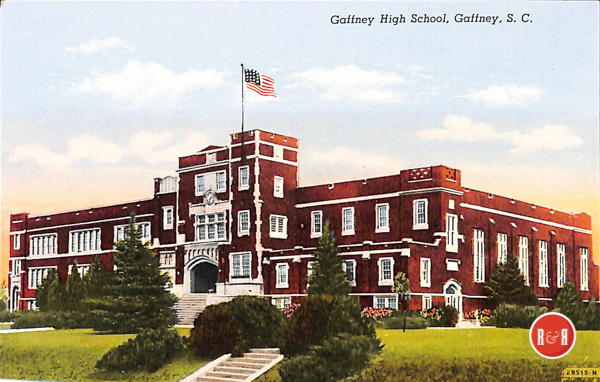
Courtesy of the AFLLC Collection – 2017
There are four white churches and four colored churches in Blacksburg. The Baptist, Methodist, Presbyterian, and Episcopal churches are all substantial and handsome structures, while the churches of the colored people are neat and comfortable buildings. This section abounds in a great diversity of valuable minerals. The iron ore is taking the lead and its latest developments have been marvelous. The soft ores were the only species that could be worked in the charcoal blast furnaces of the old regime, but now the most valuable ores, the hard ones, which are found in great quantities, can be reduced in the stone coal hot blast furnaces.
A company has been formed of Atlanta and Birmingham capitalists, known as the Magnetic Iron and Steel Ore Company, and are now, with a strong force of hands, exposing immense lodes of iron ore at and around Blacksburg. A Richmond company has also begun operations. Both companies have considerable means and have bought several thousand acres of mineral lands. An average of these ores on analysis shows from 60 to 65 per cent. The iron ores occur in lodes. The richest yet discovered is the Black-Wilson lode. This lies near the surface and seems to cover a great extent and is made up of the very finest magnetic oxides. Lying beside the iron ore is limestone and manganese used in the manufacture of steel. Around this locality is found the grey or magnetic oxide, and the red or hermatite ores, limestone, manganese, kaolin, fireproof clay, tin, asbestos, talcose, with a variety of clays and slates. These minerals are found along the King’s Mountain range, on which Blacksburg is located, and in Broad River that runs directly across this formation. By dredging these minerals can be taken from the bottom of the river. In company with Col. J.H. Averill, Mr. W.E Marshall, and Major J.E Jones, who kindly drove the party to one of the mines, this correspondent had an opportunity of seeing the vast quantities of valuable ore that have already been extracted from the mines. All the mines in and around Blacksburg will be worked as soon as sufficient machinery can be brought to this place. Prof. Pratt, the State geologist of Georgia, who has visited Blacksburg at different times and made thorough investigations of the ores and their mineralogical situation, says that the ore is of and their mineralogical situation, says that the ore is of the best and most valuable quality, and from all appearances the deposit is exhaustless. A large quantity of ore has already been shipped from this place to different points.
In this connection it may be well to state that if the water transportation can be had at Charleston, large quantities of ore will be shipped over the Three C’s Road to eastern points via Charleston, and thus Charleston will reap a benefit from the mineral deposits of this section.
One of the attractions of Blacksburg is Whittaker’s Mountain, upon which a park is now being laid out which will be known as “Overlook Park.” In the centre of the park, on the very highest portion of the mountain, is now being built an observatory which will be fifty-two feet in height and will be handsomely furnished with every convenience and a fine glass. The work is being done under the direct supervision of Major J.F. Jones.
The scenery from the top of the mountain is grand and sublime and is said to equal, if not surpass, that which is obtained from the Battery Park Hotel in Asheville. The Blue Ridge range can be easily seen, and as we stood on the celebrated Indian mound and looked toward Charleston the spire of St. Michael’s was almost visible (in imagination), while on the other side the cities of Chicago and Cincinnati were some distance beyond the horizon. The scene was a dream, and it would require a poet’s pen to describe the profound loveliness and grandeur of the surrounding country. It is proposed to build a hotel on the mountain, but no decided action has been thus far taken in the matter. On the south side of this mountain the now celebrated cavern and underground river are natural attractions. None of the party who visited the mountain manifested any desire to descend into the well, or cavern, and so we did not visit that place. Dr. John G. Black, Col. R.A. Johnston, Major John F. Jones, and M.R. Reese have formed a joint stock company for the purpose of opening and exploring the cavern, and the work is progressing as rapidly as possible, although no developments of an important nature have yet been made.
It will thus be seen that the resources of Blacksburg are numerous and valuable. The people here are alive to the needs of the hour and are making use of their resources in a manner that insures abundant success.
Reprinted from South Carolina in the 1880s: A Gazetteer by J.H. Moore, Sandlapper Publishing Company – 1989



